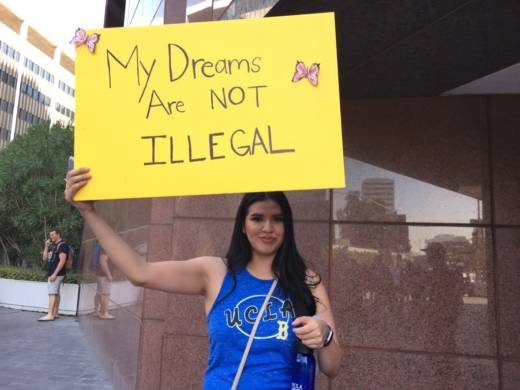And now he has used Twitter to say:
Republicans must go to Nuclear Option to pass tough laws NOW. NO MORE DACA DEAL!
What was the significance of March 5?
When Trump rescinded the program in September, enrollees whose DACA status was expiring between September 5 and March 5 had just one month to apply for a final two-year renewal. If your eligibility was coming up for renewal March 6 or later, you would be shut out.
Instead, two federal court injunctions in the past months have kept DACA going, for now. But there are some key caveats:
- DACA enrollees may continue to renew their status
- But no new applicants can apply
What happened between Trump’s September decision to sunset the program and the court injunctions?
Some people have lost protections, including people who did not make the initial one-month window for renewals.
After the first court injunction, which re-opened renewal applications, roughly 11,000 DACA recipients filed requests between Jan. 10 and Jan. 31. Of those, according to federal data almost 2,000 were people whose protection expired before March 5, meaning they should have been able to apply by last Oct. 5.
According to U.S. Citizenship and Immigration Services, the number of people with DACA protection has declined in recent months, from about 689,800 as of last Sept. 4 to about 683,000 as of Jan 31.
Why did the federal courts intervene?
Several lawsuits were filed after DACA was rescinded, including a lawsuit filed in September by the University of California system that alleged the Trump administration was unconstitutionally violating the rights of its students by ending the program, and that the decision to end DACA was "arbitrary and capricious."
The state of California, joined by three other states, also filed suit, arguing that the administration violated federal laws when it rescinded DACA.
The Jan. 9 ruling came out of the California litigation. A second federal court ruling in New York last month came out of similar litigation.
Why did the U.S. Supreme Court reject the White House request to take up the matter earlier this year?
The Trump administration asked the Supreme Court for an expedited review of the Jan. 9 ruling by a federal judge in San Francisco, which would have allowed administration attorneys to bypass the Ninth Circuit Court of Appeals, also in San Francisco.
The justices said no. The high court very rarely grants such requests. The administration will need to follow the normal appeals court route. If the administration is unhappy with Ninth Circuit’s decision, then it can appeal again to the Supreme Court.
Until that happens, the district court ruling remains in place and DACA recipients can continue to renew their work permits and deportation protections.
Lower courts in California and New York have not ruled on the merits of DACA but rather on whether the Trump administration acted legally in the way it rescinded the program.
How long will DACA remain in place?
That's unclear.
The federal appeals courts in California and New York, where the two lower court decisions were made, could ultimately rule in favor of the Trump administration. If so, the window for DACA renewals could then close. If they rule against the administration, the window could remain open longer as the cases move to the Supreme Court, as they are expected to do.
If the high court does take up DACA, a decision would be unlikely before next year.
The Trump administration could seek other ways to end DACA. Several lawsuits, including the California case on which the lower court ruled, alleged that the administration's decision to rescind DACA violated the Administrative Procedures Act. The government could conceivably fix any alleged violations.
What's going on in Congress?
Lawmakers have attempted to come up with a compromise to let young unauthorized immigrants who arrived in the U.S. as children stay legally, but none of the bills introduced have garnered enough support. A series of measures voted on in the Senate have failed to pass.
In February, Sen. Richard Durbin (D-Illinois) told NPR that the midterm elections - and whoever gets elected to the House and Senate - will likely decide the fate of DACA.
